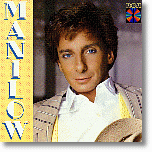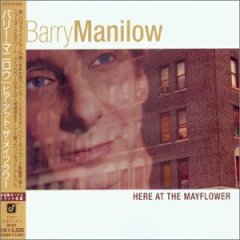
"Copacabana", also known as "Copacabana ", is a song recorded by Barry Manilow. Written by Manilow, Jack Feldman, and Bruce Sussman, it was released in 1978 as the third and final single from Manilow's fifth studio album, Even Now (1978).
Greatest Hits Volume One may refer to:

Barry Manilow is the debut album by Barry Manilow. It was released as Barry Manilow in 1973, then re-mixed and re-released as Barry Manilow I in 1975.

Greatest Hits is the first greatest hits album by singer/songwriter Barry Manilow, released in 1978. The album was certified 3x platinum in the US, and would be Manilow's last of that certification as of 2010. It also features the new single, "Ready to Take a Chance Again", which reached #11 in the US the same year. The US CD version has been released in 3 slightly different incarnations, but the first pressing featured the regular version of "Copacabana" (4:01), and the studio, non-hit, version of "Daybreak" (3:09)."Jump Shout Boogie" was omitted from all 3 versions.

Greatest Hits Vol. II is the thirteenth album released by singer-songwriter Barry Manilow. In Britain, Manilow's first Greatest Hits album had been issued as Manilow Magic, thus this second volume was issued there as A Touch More Magic.

Manilow is the self-titled album released in 1985 by singer-songwriter Barry Manilow. The album had little impact on the charts. The album features 1980s style rock n' roll/ synthesizers. He was lured away from Arista Records, but as cited by Manilow in an interview, the executives who brought him over were no longer there when the album was released. This may have led to poor record sales, as well as the album sound being primarily a modern uptempo and synthesized release sharply different from Manilow's renowned piano ballads.

Barry Manilow is the sixth self-titled album released by singer and songwriter Barry Manilow. Manilow released a total of five self-titled albums in his career: Barry Manilow, Barry Manilow II, Barry, Manilow, and this album with the same title as his first. The album was released in 1989, and reached Gold certification. This album also represented a hint of future album releases... 95% of the songs were not written/co-written by Manilow, which had until that point been rare. Manilow, known for being a composer, typically always stocked his albums with material he co-wrote with his celebrated lyricists. After the release of this album, the 1990s dawned and a new era in his career began as he embarked on introducing contemporary audiences to pop music of the 1930s through the late 1940s. This album is also one of his longest of original material, clocking in at nearly an hour.

Here at the Mayflower is an album by Barry Manilow, releases in 2001. The album concept is based on the Brooklyn, New York apartment complex Barry Manilow grew up in. The album marked the first album to include all original material since 2:00 AM Paradise Cafe in 1984.

"Could It Be Magic" is a song with lyrics by Adrienne Anderson and music by Barry Manilow, based on Frédéric Chopin's Prelude in C Minor, Opus 28, Number 20. Initially released in 1971 by Featherbed, produced and co-written by Tony Orlando, it was later re-recorded as a Barry Manilow solo track, given a first album and single release in 1973 on Bell Records and - after being remixing - an album and single re-release in 1975 on Arista Records. The 1975 re-release became one of Manilow's first hits. The song has been recorded by a number of other artists over the years, most successfully by Donna Summer in 1976 and by Take That in 1992.
Greatest Hits Volume Three may refer to:

The Complete Collection and Then Some... is a four-disc and one video greatest hits compilation by American pop singer Barry Manilow. It features 70 tracks including unreleased songs and five new recordings. It was certified RIAA gold. Originally released in 1992 with a VHS cassette, this box set was re-released on September 6, 2005, with a DVD replacing the tape.

Dionne is a 1979 album by the vocalist Dionne Warwick. It was recorded during the winter of 1978–79, and was released in the spring of 1979. The LP was originally issued as number AB-4230 in the Arista Catalog. The album stands as the biggest selling album of Warwick's career, being certified Platinum in the U.S. for sales in excess of 1 million copies.

The Greatest Songs of the Seventies is Barry Manilow's follow up to his previous album, The Greatest Songs of the Sixties. The album was released on September 18, 2007. Album producer Clive Davis said about Manilow: "No one can reinvent the great classics better than Barry Manilow. He breathes new life and vitality into these truly wonderful songs and they sound fresh and timeless. We continue on the mission to bring to a new generation the great songs of a different era." Davis has worked with Manilow since the 1970s and have been good friends. The album was released under Arista Records. It also features some of Manilow's hits in acoustic.

"Somewhere Down the Road" is a popular song written by Cynthia Weil and Tom Snow and most famously recorded in 1981 by Barry Manilow. Weil wrote the song's lyrics and Snow wrote the melody.

The Greatest Love Songs of All Time is a studio album by American singer Barry Manilow, released on 26 January 2010 through Arista. The release came not too long before the start of his new show at the Paris Las Vegas hotel.

Greatest Hits Volume III is a compilation album released by Barry Manilow in 1989 on Arista Records. It was the third of a three-album series released that year, along with Volume I and Volume II.
Adrienne Anderson is an American songwriter, most notable for being the co-writer of "Could It Be Magic", among other Barry Manilow songs, as well as being the co-writer of signature songs for Dionne Warwick and Peter Allen.
Greatest Hits, Vol. 2 is a collection of ten previously released singles by Ray Stevens, released in 1987. It is the second volume of the Greatest Hits package of Stevens' music that was released by MCA Records. Of the ten selections on this volume, the fifth track, "Mama's in the Sky With Elvis," makes its first album appearance. Additionally, this collection consists of five recordings for MCA Records, two for Warner Bros. Records, two for Monument Records and one for Mercury Records.
















